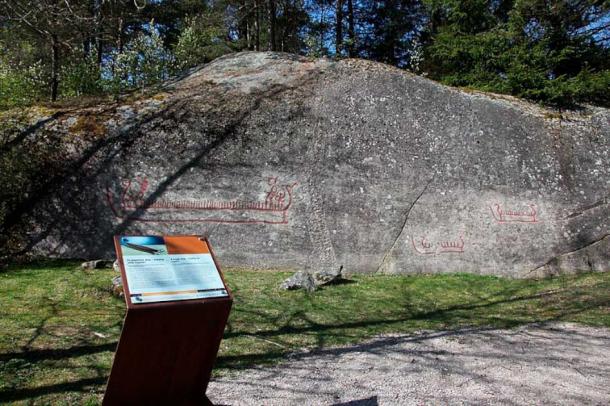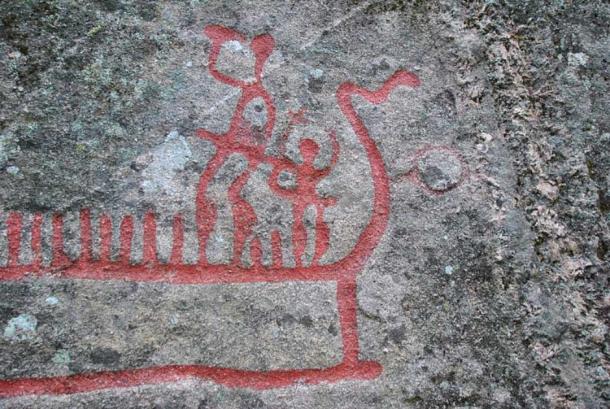The Bjornstad Ship: A Rare Window into the Nordic Bronze Age
Situated near Sarpsborg, Norway, the enigmatic Bjørnstad ship is a fantastic glimpse into the prehistoric, pre-Viking age of Scandinavia. Such ancient carvings are few, and often hard to discover – and each new one we study is so precious in understanding the origins of the Vikings and the cultures of modern Scandinavia. But who exactly carved this magnificent ship into the rock – and more importantly, for what reason?
The Bjørnstad Ship Sails in from the Past
The origins of the Vikings – those ferocious seafarers that changed the history of the world in many ways – lie securely in the famous Nordic Bronze Age. This is an enigmatic period of Northern Europe, when its peoples and forming cultures were left to develop their distinct identity with minimal influence from the rest of Europe. Thousands of years before the Vikings formed as a distinct culture, the Scandinavian way of life was dominated by the sea, the fjords, shipbuilding, a semi-nomadic lifestyle, seafaring, and hunting.
In the Nordic Bronze Age , these cultural aspects were refined and became a cornerstone of Scandinavian life, later cemented by the emerging Norsemen that we all know. But even so, with all the modern research and archaeology, the Nordic Bronze Age is largely enigmatic. What little we know for certain comes from archaeological excavations, and more intriguingly – from rock carvings.
The Prehistoric Petroglyphs of Scandinavia
Scandinavia has arguably the largest density of petroglyphs – special rock carvings that dot the landscapes of the North. They depict warriors, animals, hunters and their prey, towering deities and symbols of the sun. And above all, ships.
These Bronze Age petroglyphs are by far the best method of understanding the origins of seafaring in Scandinavia, and the Bjørnstad Ship carving is perhaps the best of all.
- Five Huge Bronze Age axes discovered in a field in Jutland, Denmark
- Viking Ships: More than Fearsome Weapons of the Open Seas

Bjørnstad Ship site is south of Oslo, in Sarpsborg, Norway, and includes a long ship and two smaller ships, carved in the Bronze Age. The longest ship carving is over 4 meters long. (Hans A. Rosbach/ CC BY-SA 3.0 )
The Norsemen Epitomized in Stone
The Bjørnstad Ship is thought to be the largest rock carving in Northern Europe. It is a magnificent sight to behold, measuring roughly 4.5 by 1.5 meters (14 by 5 ft). Rising on the vertical face of a huge boulder, nested in the countryside not far from the city of Sarpsborg, the petroglyph depicts a huge, rowed longship, with two simpler, smaller ships to the side.
The carvings were likely re-discovered around 1946, when the site was cleared and the markings of the ships made out. Ever since, it has captivated the attention of scholars and archaeologists.
Based on the appearance of the carvings, and their differences, scholars agree that their dates are not the same. The two smaller, simpler ships off to the side, are likely much older than the Bjørnstad Ship, and were made by the early Bronze Age hunter-gatherers. Judging from this, it is thought that they depict small skin-covered boats that were used for hunting marine mammals during this early age.
But the majestic Bjørnstad Ship is likely younger, carved with skill and precision by the semi-sedentary farmers of the later Bronze Age, the men and women who can be considered the true ancestors of the Vikings.
The ship depicted is a sleek and fast rowing boat, virtually identical to the famous Hjortspring boat that was excavated in Denmark and dated to the Iron Age . If the artist’s depiction is accurate, then the Bjørnstad Ship likely had seats for up to 40 rowers and more – making it a true warship of old.
At the bow and the stern, two human figures are represented, holding objects. They could either be deities, or famed warriors setting sail.

Detail of the marvellous Bjørnstad Ship carving. (Thomas M. Hansen/ CC BY-SA 3.0 )
The Sea-Craft of Ancient Peoples
Both the Bjørnstad Ship, and all the other ship petroglyphs in their thousands, tell us that the sleek longboat played the central role in the Nordic Bronze Age society. It was an instrument of might – of seafaring, warfare, trade, and exploration. The refined longboat was, in every way, a way of survival for these peoples. It was fast and powerful, and connected brotherly peoples of old – and enemies as well.
Modern research tells us that a boat such as one depicted at Bjørnstad and the one excavated at Hjortspring could have journeyed from Norway to Denmark in just 18 hours. An impressive time for the period.
There is no doubt that the longboat placed the Norse one step ahead of their neighbors. It is certain that, because of its importance, the longboat was seen as something of a divine instrument. And these petroglyphs, the Bjørnstad Ship carving in particular, was likely a place of worship, a sacred sight, where the legendary boat became a divine weapon of the gods themselves.
The clues to these claims lie beneath the ground. In the 1970s, during excavations at the site, archaeologists discovered remains of pottery, tools, stone paths and raised walls. This cliff face, and many others across Scandinavia, were obviously sacred sites, and the petroglyphs were the frescoes of old.
The Sun Journeys by Boat
The peoples of the Nordic Bronze Age had a firm belief in the Sun and its powers. Sun worship was widespread, and many of the rock carvings have a sun depicted on them. The Bjørnstad Ship is no exception. Modern interpretations all agree that this is a religious image: the sleek longboat carries the Sun itself, as many of the ancient Scandinavian myths tell us. The figures on the bow and stern are likely deities, guarding the Sun as it makes its journey across the skies.
To see the Bjørnstad Ship carving for yourself, you will have to take the Haugeveien road (county road 583), for roughly 3 kilometers (2 miles) from Hafslund Chapel, and simply follow all the signs towards the boulder and the carving. The scenery is lovely, and the prize awaiting is a rare glimpse into the ancient way of life in Scandinavia.
Related Post
A shocking documentary proves that mermaids do exist
SHOCKING Revelation: Thuya, Mother of Queen Tiye, Was the Grandmother of Akhenaten and Tutankhamun—What Ancient Egyptian Secrets Did She Leave Behind?
Breaking News: Astonishing Discoveries at Karahan Tepe Confirm an Extraterrestrial Civilization is Hiding on Earth, and NO ONE Knows!
Breaking News: Researchers FINALLY Discover U.S. Navy Flight 19 After 75 Years Lost in the Bermuda Triangle!
NASA’s Secret Investigation: Uncovering the Astonishing Mystery of the UFO Crash on the Mountain!
Explosive UFO Docs LEAKED: Startling Proof That Aliens Ruled Ancient Egypt!